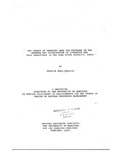| dc.contributor.author | Wargute, PW | |
| dc.date.accessioned | 2013-05-10T08:37:58Z | |
| dc.date.available | 2013-05-10T08:37:58Z | |
| dc.date.issued | 1992-02 | |
| dc.identifier.citation | Wargute, P.W(1992). The impact of changing land use patterns on the numbers and distribution of livestock and wild herbivores in the Tana River District, Kenya | en |
| dc.identifier.uri | http://erepository.uonbi.ac.ke:8080/xmlui/handle/123456789/21138 | |
| dc.description | Master of Natural resources | en |
| dc.description.abstract | The intent of this study was to examine the impact of
changing land use patterns on the numbers and distribution
of livestock and wild herbivores in the Tana River District,
Kenya.
A multi-method approach of aerial surveys,
questionnaires, interviews and secondary data sources were
employed to realize the objectives.
Results indicate that changes in land use patterns and
types have created conflicts that led to the reduction of
the range and affected distribution of pastoral livestock
and wild herbivores. Land use changes, such as irrigation
are possibly responsible for reduction in the numbers and
distribution of pastoral livestock and wild herbivores.
Parks, reserves and ranches have also reduced the range of
pastoral livestock. The creation of ranches has yet to
affect wild herbivore distribution because of minimal
development of the ranches but in future, wild herbivores
may be affected.
Other factors responsible for reduction in numbers
include diseases and pests, drought and poaching. Poaching
is directly responsible for the decline in elephant and
rhinoceros populations. The droughts of 1979 and
particularly that of 1984 also contributed to reductions in
numbers of livestock and wild herbivores.
Orma pastoralists attribute the curtailment of the
grazing range of theii stock to the influx of Somali
pastoralists. Overgrazing due to this influx and large
herds of livestock have rendered some range areas bare.
To alleviate the land use conflicts strategies
recommended include: multiple land use practice; continued
conservation of animals in parks and reserves; compensation
of farmers for losses suffered; provision of corridors for
access to grazing and watering areas; and allowing
pastoralists into reserves during periods of drought. | en |
| dc.language.iso | en | en |
| dc.subject | Land use | en |
| dc.subject | Distribution | en |
| dc.subject | Livestock | en |
| dc.subject | Wild Herbivores | en |
| dc.subject | Tana River District | en |
| dc.subject | Kenya | en |
| dc.title | The impact of changing land use patterns on the numbers and distribution of livestock and wild herbivores in the Tana River District, Kenya | en |
| dc.type | Thesis | en |
| local.publisher | Department of Range Management, University of Nairobi | en |

